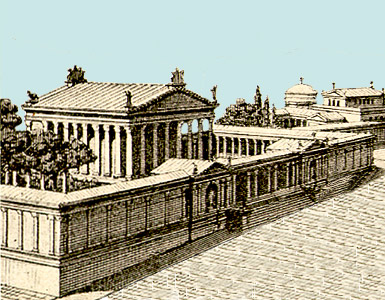
You walk between the towering complexes of imperial palaces and suddenly step into a wondrous space where the air tastes slightly of bay leaf, wafted to you from the nearby laurel trees.
Directly ahead you see one of Rome's most beloved temples, that erected by Augustus in honor of Apollo on the Palatine. You may walk forward to the steps of the temple, or turn east toward the Bibliotheca, or turn west, where a ramp leads toward the Domus Augusti, which was the residence of the emperor Augustus. Or you may walk into the shade of the portico to examine its numerous statues more closely (see this model of the complex). In the center of the temple's courtyard stands the altar of the god, where Augustus as chief priest (pontifex maximus) may have presided; beside the altar stands a statue of Apollo Actius (giver of victory at the battle of Actium), whose symbolism contains many elements of peace and harmony--flowing robes, the lyre, a libation bowl--as can be seen in this relief. Click on his statue below for more information, especially about the representation of this temple in the Aeneid. Surrounding the altar are four bronze cattle superbly executed by the Greek sculptor Myron. How bucolic!
An ancient Roman poet, Propertius, visiting the temple shortly after its opening, recorded his impressions of this site; click on one of the objects below to read his description in Latin or English. As you explore this site you will see in more detail many of the features that Propertius mentions in this poem.
![]() To follow Tristia Tresunus to his seventh stop, take the Scalae Templi
exit; to make your way to his eighth stop, take the
Porticus exit. If you are heading toward his ninth stop, take the
Area Sacra exit
To follow Tristia Tresunus to his seventh stop, take the Scalae Templi
exit; to make your way to his eighth stop, take the
Porticus exit. If you are heading toward his ninth stop, take the
Area Sacra exit